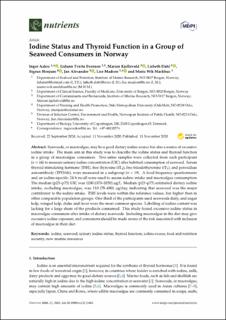Iodine status and thyroid function in a group of seaweed consumers in Norway
Aakre, Inger; Evensen, Lidunn Tveito; Kjellevold, Marian; Dahl, Lisbeth; Henjum, Sigrun; Alexander, Jan; Madsen, Lise; Markhus, Maria Wik
Peer reviewed, Journal article
Published version
Permanent lenke
https://hdl.handle.net/11250/2723109Utgivelsesdato
2020Metadata
Vis full innførselSamlinger
- Articles [3012]
- Publikasjoner fra CRIStin [3070]
Sammendrag
Seaweeds, or macroalgae, may be a good dietary iodine source but also a source of excessive iodine intake. The main aim in this study was to describe the iodine status and thyroid function in a group of macroalgae consumers. Two urine samples were collected from each participant (n = 44) to measure urinary iodine concentration (UIC) after habitual consumption of seaweed. Serum thyroid stimulating hormone (TSH), free thyroxine (fT4), free triiodothyronine (fT3), and peroxidase autoantibody (TPOAb), were measured in a subgroup (n = 19). A food frequency questionnaire and an iodine-specific 24 h recall were used to assess iodine intake and macroalgae consumption. The median (p25–p75) UIC was 1200 (370–2850) μg/L. Median (p25–p75) estimated dietary iodine intake, excluding macroalgae, was 110 (78–680) μg/day, indicating that seaweed was the major contributor to the iodine intake. TSH levels were within the reference values, but higher than in other comparable population groups. One third of the participants used seaweeds daily, and sugar kelp, winged kelp, dulse and laver were the most common species. Labelling of iodine content was lacking for a large share of the products consumed. This study found excessive iodine status in macroalgae consumers after intake of dietary seaweeds. Including macroalgae in the diet may give excessive iodine exposure, and consumers should be made aware of the risk associated with inclusion of macroalgae in their diet.
